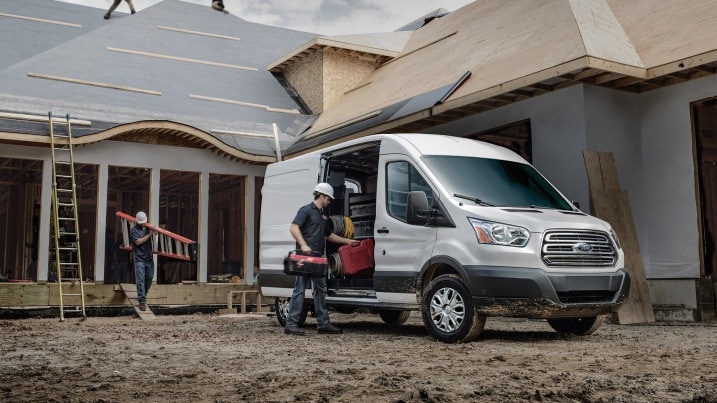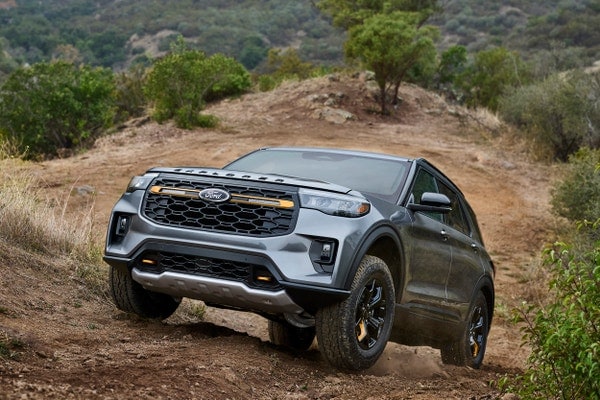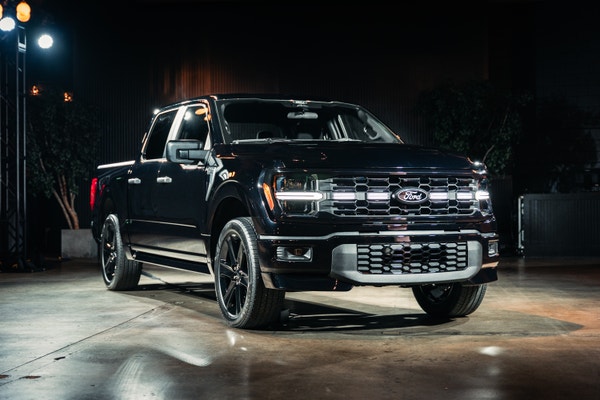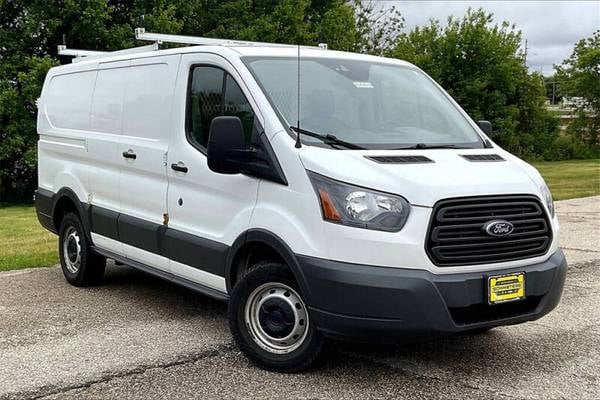2017 Ford Transit Van Review
Price Estimate: $14,198 - $17,445
 View 440 more photos
View 440 more photos View 440 more photos
View 440 more photos View 440 more photos
View 440 more photos View 440 more photos
View 440 more photos View 440 more photos
View 440 more photos+436
Oops, we can’t seem to locate you.
Please enter U.S. ZIP code to see vehicles for sale
Edmunds' Expert Review
Pros
- Numerous available configurations help provide plenty of cargo-carrying capability
- Strong and fuel-efficient gasoline and diesel engines
- Sync 3 infotainment system is extremely easy to use
- Pleasant road manners for a van
Cons
- Lack of available V8 engine may be a turn-off for traditional van buyers
What’s new
Last year's LED cargo lighting package is standard on all Transit vans. The 3.7-liter V6 is now the default engine for models equipped with dual rear wheels. A short-wheelbase variant of the heavy-duty Transit 350 is now available. New options include upgraded driver and passenger seats with a heating function and power-retractable running boards.
Vehicle overview
If you're a business owner and frequently find yourself needing to move large amounts of equipment or product, it's hard to beat the versatility and capability of a full-size cargo van. And as cargo vans go, the 2017 Ford Transit Van is close to being a no-brainer pick. With the Transit, you get your choice of two wheelbases, three body lengths and three roof heights. Go all out and the most spacious combination will give you a massive cargo area with 487.3 cubic feet of storage. This absolutely eclipses the Chevrolet Express Cargo's paltry capacity of 284.4 cubic feet and is just ahead of the Ram ProMaster's 463 cubic feet.
For sale nearby
690 listings
- $15,989fair price$39 below market
- 129,031 miles
- 2 accidents, 1 owner, personal use only
- 2 Seats
- Schwieters Ford of Montevideo (116 mi away)
- Back-up camera
- Tire Pressure Warnin...
- Stability Control
- Aux Audio Inputs
- Post-collision safet...
Close
Located in Montevideo, MN
AutoCheck Vehicle History Summary
Accident Free Vehicle: No
Personal Use Only: Yes
History Provider: AutoCheck
Title Details: Clean Title
Salvage Vehicle: No
Frame Damage: No
Theft History: No
Lemon Status: No
Free History Report: Yes
Features and Specs:
Listing Information:
VIN: 1FTYR1ZMXHKB46958
Stock: B46958
Certified Pre-Owned: No
Listed since: 05-23-2025 - 165,609 miles
- 1 accident, 1 owner, corporate fleet vehicle
- 2 Seats
- Twin City Motors (131 mi away)
- Back-up camera
- Tire Pressure Warnin...
- Stability Control
- Aux Audio Inputs
- Post-collision safet...
Close
Located in Grand Forks, ND
2017 Ford Transit Cargo Quigley 4x4! 3.7L V6 Automatic! 165k Miles! Power Hookups! Hard to Find! Great for Small Business! Clean Unit! Clean Title! Go...
AutoCheck Vehicle History Summary
Accident Free Vehicle: No
Personal Use Only: No
History Provider: AutoCheck
Title Details: Clean Title
Salvage Vehicle: No
Frame Damage: No
Theft History: No
Lemon Status: No
Free History Report: No
Features and Specs:
Listing Information:
VIN: 1FTYE1YMXHKA47778
Stock: A47778
Certified Pre-Owned: No
Listed since: 02-06-2025
Each new model year brings the all-purpose Transit further away from its forebear, the iconic Econoline. The list of improvements for 2017 is short compared to last year's additions of the Sync 3 infotainment system, dual sliding side doors and standard rearview camera. Still, the new standard wheelbase version of the Transit 350 is sure to entice buyers who carry moderate amounts of heavy materials. There's also new standard equipment (last year's optional LED Compartment Lighting package) and available features (power-retractable running boards to aid cabin ingress and egress).
The 2017 Ford Transit Van is one of the best in its segment, but there are a few others that may be more suitable for your needs. The Mercedes-Benz Sprinter is a little more expensive but offers even more cargo space than the Ford: a class-leading 586 cubic feet. If you need to tow, the Nissan NV is available with a 5.6-liter V8 that tows up to 9,500 pounds, much more than the Transit. The front-drive Ram ProMaster is much less expensive than these options and its smaller size makes it easier to park in congested cities. There's also the Chevrolet Express, but it's quite dated, and its cargo capacity is much lower than rival vans. Overall, though, we highly recommend the 2017 Ford Transit considering its well-rounded nature.
All Transit Vans get stability control, antilock brakes, and frontal, side curtain and front side-impact airbags and a rearview camera as standard equipment. A new standard system called Side Wind Stabilization helps keep the Transit tracking straight if it is hit by wind gusts. Rear parking sensors and a lane departure warning system are options; note that the latter is included with the Sync 3 infotainment upgrade.
In government crash testing, the Transit Van was awarded four out of five stars for front crash protection
Edmunds' Expert Rating
Full-size vans are a lot more sophisticated than they used to be. Check out the 2017 Ford Transit, for instance. With a wide variety of configurations, a choice of powerful and fuel-efficient engines and easygoing driving manners, this feature-rich van should meet all of your commercial business needs.
Driving
The first thing drivers will notice is that the 2017 Ford Transit Van handles the road in a way no truck-based van could hope to match. The steering responds easily and gives feedback more like a family car than a full-size truck. A relatively tight turning circle is another welcome attribute of the Transit. Well-managed road and wind noise make the Transit's cabin quieter than the norm for full-size vans, although pelting rain hammers the roof and can generate considerable noise in the cavernous cargo bay.
The Transit's standard 3.7-liter V6 has respectable power but may be a bit lacking for those planning to transport a lot of heavy cargo on a regular basis. The turbocharged 3.5-liter V6 is a different animal, as it effortlessly propels even a fully loaded Transit. The 3.2-liter diesel is quiet and gutsy, though it ultimately lacks the oomph of the 3.5-liter V6. Like the other two engines, it cooperates almost invisibly with the standard six-speed automatic transmission.
Interior
A big advantage of the 2017 Ford Transit Van compared to the old E-Series van is the generously low step-in height. No more climbing and clambering over wide sills to enter the cabin, and there's no need to use the rear bumper as a stair when stepping inside the cargo area either, thanks to a low floor. The tall center console, close-to-hand gear selector and easy-to-access audio and climate controls work in harmony to make the drive go more smoothly. If you care about the latest infotainment technology, using the new-for-last-year Sync 3 interface feels like operating your smartphone. Large virtual buttons are easy to push even if you aren't paying strict attention to the screen, and the navigation system incorporates familiar functions like pinch-to-zoom and swiping gestures.
The extended-length version of the 2017 Transit on the 148-inch wheelbase can carry 14-foot lengths of pipe or lumber with the doors shut. The shortest version of the van, on the standard 130-inch wheelbase, can carry items up to 10 feet in length with the doors closed. Workers up to 6-feet 5-inches tall can stand upright in the high-roof Transit Van. Full 4-by-8-foot sheets of plywood can lie flat inside all but the models equipped with the optional dual rear wheels.
Cargo area volume runs from 246.7 cubic feet in the low-roof, standard-wheelbase model to a whopping 487.3 cubic feet for the long-wheelbase, extended-length van.
Compare 2017 Ford Transit Van trim levels
Helpful trims summary and side-by-side comparison chart
2017 Ford Transit Van models
The 2017 Ford Transit Van is a full-size cargo van offered in a single trim level. There are standard- and long-wheelbase models as well as low-, medium- and high-roof body styles. An extended-length body can be had on the long-wheelbase chassis. Depending on the configuration, the Transit also can be selected to handle increasing gross vehicle weight ratings: Transit 150, Transit 250 and Transit 350.
Standard equipment for the Transit Van includes 16-inch steel wheels, a rearview camera, a hinged passenger-side door (sliding on medium- and high-roof models), a tilt-and-telescoping steering wheel, full power accessories, remote locking/unlocking, front air-conditioning, vinyl upholstery, a two-speaker stereo with an auxiliary input jack and tie-down loops and LED lighting in the cargo area.
Options can be ordered alone or come as part of packages. Highlights include long-arm exterior mirrors, various window choices, different axle ratios, dual sliding rear cargo doors, power-retractable running boards, cruise control, rear parking sensors, leather upholstery, automatic headlights and wipers, a lane departure warning system, remote engine start, rear air-conditioning, a spray-in liner for the cargo area, Ford Telematics, Ford's Sync voice controls with a 4-inch multifunction display or the Sync 3 infotainment interface with navigation, HD and satellite radio, a USB port and a 6.5-inch touchscreen. A heavy-duty trailering package is also offered.
The base engine in the 2017 Ford Transit Van is a 3.7-liter V6 delivering 275 horsepower and 260 pound-feet of torque. All Transit Vans are rear-wheel drive and come equipped with a six-speed automatic transmission with a manual mode.
Upgrades include a turbocharged 3.2-liter five-cylinder diesel rated at 185 hp and 350 lb-ft of torque, and a turbocharged 3.5-liter V6 capable of 310 hp and 400 lb-ft of torque. A CNG/propane engine prep package option is available for the 3.7-liter V6.
Although payloads and towing capacities were not available at time of publication, they shouldn't change much from last year's model. Capacities vary with each model, ranging from 2,740 pounds to 4,560 pounds for payload and from 2,900 pounds to 7,500 pounds for towing when properly equipped.
Fuel economy for 2017 wasn't available at the time of publishing, but we don't expect the Transit's fuel economy to change much (if at all) from last year. Last year's regular-wheelbase Transit Wagon passenger van with the 3.7-liter V6 was EPA-rated at 16 mpg combined (14 mpg city/18 mpg highway). The same model powered by the 3.5-liter turbocharged V6 was marginally different, earning 16 mpg combined (15 city/19 highway). Because of the rules governing commercial vehicles, there's no other fuel economy data available for the Transit's other models.

2026 Ford Explorer Tremor Gets 400-HP V6 and Off-Road Duds

2025 Ford Maverick Hybrid: What's It Like to Live With?

The 2025 Ford F-150 Lobo Is Just an Appearance Package

Ford Mustang Dark Horse vs. Cadillac CT4-V Blackwing: The Edmunds U-Drags Battle
Cost to Drive
Monthly estimates based on costs in North Dakota
Not EPA tested for Transit Van 150 Low Roof
Transit Van 150 Low Roof
vs
$270/mo
Avg. Midsize Van
See Edmunds pricing data
Has Your Car's Value Changed?
Used car values are constantly changing. Edmunds lets you track your vehicle's value over time so you can decide when to sell or trade in.

Reliability Ratings by RepairPal
2.5 out of 5 stars2.5/5Average
#12 out of 24 among Commercial Vans
RepairPal Reliability Ratings are based on the actual cost, frequency, and severity of unscheduled repairs and maintenance on make/model data for select 2008-2022 vehicles. The reliability of a specific vehicle may vary depending on its maintenance and driving history, model year, trim, and features.
Cost
$1,025/yr
vs. $851/yr
for Average Commercial Van
for Average Commercial Van
Frequency
1.59x/yr
vs. 1.96x/yr
for Average Commercial Van
for Average Commercial Van
Severity
18.3%
vs. 17.8%
for Average Commercial Van
for Average Commercial Van
powered by RepairPal
Ford Transit Van Owner Reviews
Most Helpful Owner Reviews
Trending topics
Another ford lemon
2 out of 5 starsDisappointed, 11/29/2016
2016 Ford Transit Van 250 Low Roof 3dr Cargo Van w/148" WB, 60/40 Passenger Side Door (3.7L 6cyl 6A)
Thought this would be real nice after all the issues with a transit connect, well it looks nice and has the space needed for a work truck, however it has had weird electrical issues that come and go, Bluetooth randomly won't connect to my phone. Once it had to be reset "by the dealer" at 38,000 miles. Now just over 40k, throttle body needed. Once again ford has convinced a small business … their vehicles are worth owning...wrong. Ford has and always will be the WORST most unreliable domestic vehicle brand available...more crap in a new wrapper. Pay more for anything else and don't risk your life everyday driving (or trying to) this junk.
UPDATE 6/1/17 so the throttle body failure was a common issue, parts back ordered. Got replacement, told by dealer it's all fixed, still stalls while driving, back to the lemon grove. 4 throttle bodies and 45 days later it runs correctly again. UNREAL that a company would put a consumer through this. I threatened them that it should be replaced under lemon law. So now at 56k miles, only major issue is Bluetooth forgets my phone once every couple weeks, reconnects usually. About every 6 weeks it doesnt, I reset the system by disconnect battery for 3 minutes. Then add phone back and reconnect.. spend your money elsewhere.
Pile of junk!
1 out of 5 starsRobert, 10/16/2018
2016 Ford Transit Van 150 Medium Roof 3dr Cargo Van w/130" WB, Sliding Passenger Side Door (3.7L 6cyl 6A)
I would NEVER recommend these to anyone. Rear brakes are destroyed every 20k miles. Driveshaft couplers? A complete joke, the dealers can't even fix them right! We own 9 of these and they are in the dealer more than they are out. Steer yourself the other way, buy a Nissan NV. We are done with these pieces of junk. All of the items I filled out are correct. Yes, they are that bad.
No Ford, no problem
2 out of 5 starsFCNI, 09/13/2016
2016 Ford Transit Van 250 Low Roof 3dr Cargo Van w/130" WB, 60/40 Passenger Side Door (3.7L 6cyl 6A)
Front passenger shock absorber replaced within a month of the purchase. The same thing happened to me today, Sep 12, 2016 with 6993 miles. The Van accelerator stop responding, all instrument lights flashing like a xmas tree, beeping sounds....towed the Van to a near Ford dealer, waiting to hear back from the dealer tomorrow. First and last Ford.
failed throttle body @5.6k and 3wks wait for parts
3 out of 5 starsriker, 06/27/2016
2016 Ford Transit Van 250 Medium Roof 3dr Cargo Van w/148" WB, Sliding Passenger Side Door (3.7L 6cyl 6A)
Driving this new 2016 transit, 250 medium height roof since February. With out warning van randomly loses acceleration, engine won't respond to accelerator and runs rough. Have to coast over into the break down lane and shut off/restart several times before van will drive again. Dealer telling us parts are backordered and 3 weeks out at best. Indicated they have had several other … Transits in the shop for the same issue claimed to be the throttle body. Ford will not provide rental reimbursement.
We have a limited number of reviews for the 2017 Ford Transit Van, so we've included reviews for other years of the Transit Van since its last redesign.
2017 Transit Van Highlights
150 Low Roof
| Base MSRP Excludes Destination Fee | $31,610 |
|---|---|
| Engine Type | Flex-fuel (ffv) |
| Seating | 2 seats |
| Cargo Capacity All Seats In Place | 246.0 cu.ft. |
| Drivetrain | rear wheel drive |
| Warranty | 3 years / 36,000 miles |
Safety
Key safety features on the Transit Van include:
- Back-up camera
- Tire Pressure Warning
- Stability Control
- Post-collision safety system
NHTSA Overall Rating
The National Highway Transportation Safety Administration offers independent analysis.
- Frontal Barrier Crash RatingOverall4 / 5Driver4 / 5Passenger3 / 5
- Side Crash RatingOverallNot Rated
- Side Barrier RatingOverallNot RatedDriverNot RatedPassengerNot Rated
- Combined Side Barrier & Pole RatingsFront SeatNot RatedBack SeatNot Rated
- RolloverRolloverNot RatedDynamic Test ResultNo TipRisk Of RolloverNot Rated
People who viewed this also viewed
| Starting at $56,400 |
| Starting at $44,960 |
| 4.0 average Rating out of 7 reviews. |
| Starting at $41,920 |
Related Used 2017 Ford Transit Van info
Vehicle reviews of used models
- Toyota Land Cruiser 2020 Review
- Mercedes Benz Gle Class 2021 Review
- Honda HR V 2020 Review
- Mercedes Benz Sprinter 2021 Review
- Infiniti Q60 2020 Review
Shop similar models
- Used Ford Transit-passenger-van 2025
- Used Ford Transit-crew-van 2023
- Used Ram Promaster-cargo-van 2025
- Used Ram Promaster-window-van 2025
Shop used vehicles in your area
Popular new car reviews and ratings
- 2025 7 Series
- 2025 Kia EV6 News
- 2024 Dodge Ram Pickup 1500
- 2025 Mercedes-Benz Maybach EQS SUV
- 2026 MINI Cooper Countryman News
- 2024 Solterra
- Chevrolet C/K 1500 Series 2025
- 2024 Alfa Romeo Stelvio
- 2026 Mazda CX-50 News
- New Chevrolet Silverado 3500HD
Research other models of Ford
- 2024 Transit Passenger Van
- New Ford Bronco
- Ford F-150 2024
- 2025 Ford F-150
- Ford F-450 Super Duty 2025
- New Ford F-150
- 2025 Ford Escape
- 2024 Ford Maverick
- New Ford F-250 Super Duty
- Ford F-350 Super Duty 2024
Other models
- New BMW I7 for Sale in Oak Harbor, WA
- Used Mazda Mx-5-Miata in Marion, OH 2025
- New Genesis Electrified-Gv70 for Sale in Hilton Head Island, SC
- Used Rolls-Royce Wraith in Glastonbury, CT 2021
- New Toyota Prius-Prime for Sale in Mexico, MO
- Used Chevrolet Aveo in Hallandale, FL 2011
- Used GMC Sonoma in Elmont, NY 2004
- Used Lexus RX-300 in Colonial Heights, VA 2003
- New Audi Q6-E-Tron for Sale in Eden Prairie, MN
- Used Nissan Juke in Conyers, GA 2017

